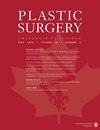Toxic Shock Syndrome as an Unexpected Complication in Outpatient Pediatric Burn Treatment: A Chart Review
IF 0.7
4区 医学
Q4 SURGERY
引用次数: 0
Abstract
Background: Minor burn injuries in children affecting less than 10% of total body surface area (TBSA) are often successfully managed in the outpatient setting, however it is important to recognize they can be associated with serious sequelae such as toxic shock syndrome (TSS). Methods: We conducted a retrospective chart review at a tertiary-level pediatric hospital between May 2012 and May 2022 to identify pediatric patients diagnosed with TSS following minor burn injuries. Data collected included: patient demographics, burn characteristics, TSS symptoms, and management. Data was analyzed using descriptive statistics. Results: During the study period, 3706 patients with minor burns were treated as outpatients, of which 6 patients developed TSS. Ages ranged from 12 to 36 months, and half were male. Most injuries were scalds (n = 4) or contact injuries (n = 2), involving 1% to 3% TBSA partial-thickness burns. Early symptoms of TSS included vomiting (n = 6) and fever (n = 5), and later, hypotension (n = 5). Hospital admission for TSS occurred 1 to 6 days post-injury. Four of the 6 patients required ICU care, with 2 of them requiring fluid resuscitation and 2 receiving IVIg. The clinical course of 2 patients was complicated by deep vein thrombosis, with 1 patient developing a septic ileus as a secondary infection. All patients recovered and were discharged home after 3 to 9 days. Conclusion: We highlight the rare complication of TSS following minor burns in children. Providers should be vigilant for early symptoms of TSS like fever, vomiting, and hypotension. Further research to identify at-risk patients and preventative treatment would be beneficial.中毒性休克综合征是儿科烧伤门诊治疗中的意外并发症:病历回顾
背景:儿童烧伤面积小于体表总面积(TBSA)10%的轻微烧伤通常可在门诊环境下成功处理,但必须认识到这些烧伤可能会导致中毒性休克综合征(TSS)等严重后遗症。方法:我们对一家三级儿科医院 2012 年 5 月至 2022 年 5 月期间的病历进行了回顾性分析,以确定被诊断为轻度烧伤后中毒性休克综合征的儿科患者。收集的数据包括:患者人口统计学特征、烧伤特征、TSS症状和处理方法。数据采用描述性统计方法进行分析。研究结果在研究期间,共有 3706 名轻微烧伤患者接受了门诊治疗,其中 6 名患者出现了 TSS。患者年龄从 12 个月到 36 个月不等,半数为男性。大多数损伤为烫伤(4 例)或接触伤(2 例),涉及 1% 至 3% TBSA 的部分厚度烧伤。TSS的早期症状包括呕吐(6例)和发烧(5例),随后出现低血压(5例)。因 TSS 而入院的患者多在伤后 1 到 6 天入院。6 名患者中有 4 人需要重症监护室护理,其中 2 人需要液体复苏,2 人接受了静脉注射。2 名患者的临床过程因深静脉血栓形成而变得复杂,1 名患者因继发感染而出现脓毒性回肠炎。所有患者均已康复,并在 3 至 9 天后出院回家。结论:我们强调了儿童轻度烧伤后并发 TSS 的罕见并发症。医疗人员应警惕 TSS 的早期症状,如发烧、呕吐和低血压。进一步开展研究以确定高危患者并进行预防性治疗将是有益的。
本文章由计算机程序翻译,如有差异,请以英文原文为准。
求助全文
约1分钟内获得全文
求助全文
来源期刊

Plastic surgery
Medicine-Surgery
CiteScore
1.70
自引率
0.00%
发文量
73
期刊介绍:
Plastic Surgery (Chirurgie Plastique) is the official journal of the Canadian Society of Plastic Surgeons, the Canadian Society for Aesthetic Plastic Surgery, Group for the Advancement of Microsurgery, and the Canadian Society for Surgery of the Hand. It serves as a major venue for Canadian research, society guidelines, and continuing medical education.
 求助内容:
求助内容: 应助结果提醒方式:
应助结果提醒方式:


